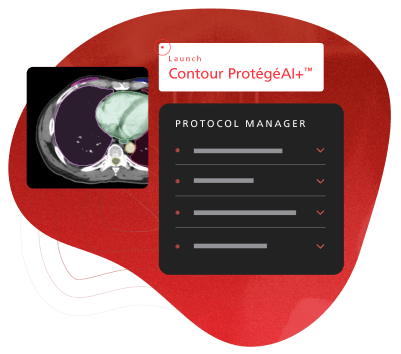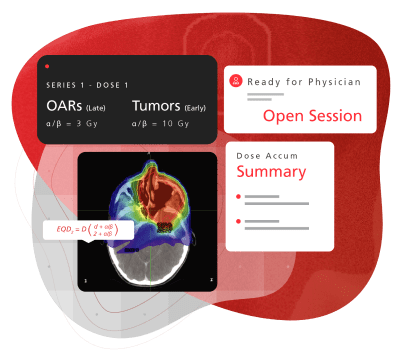Sim-to-Treatment Challenges
How Do Long Turnaround Times Affect Your Patients?
Process inefficiencies extend wait times, decrease patient satisfaction, and reduce referrals.
Growing Patient Volumes Overwhelm Clinical Capacity
Reducing time-to-treatment initiation (TTI) is critical for patient survivability. But how can care teams manage surging patient volumes, staff shortages, and growing complexity of treatment options?
It’s crucial to reassess tools and processes that impact the well-being of patients and clinicians.
Manual Processes Create Bottlenecks
Reliance on manual methods for organs-at-risk (OAR) contouring, QA checks, or image registration can severely delay patient treatment.
Without automation and standardization, the risk to care quality, consistency, and efficiency grows.
Inefficiency Leads to Burnout
Healthcare staff face increasing burnout risk due to repetitive processes, intensive software training, and siloed systems that detract from patient care.
Amid increasing healthcare volumes, care teams must be set up for success with tools that give them more time to focus on patient care.
Leading Radiation Oncology Departments Choose MIM
MIM Maestro Saves Clinics of All Sizes Time—Without Compromising Quality
600+
Clinics Use MIM AI Auto-Segmentation Daily
10+
Years of Innovations in Image Registration, Prior Delivered Dose Assessment, 4D Motion Management, and More.
MIM Maestro
Shorten Patient Wait Times with Standardization
Improve Plan Quality While Speeding Up Turnaround Times
Set Up Your Clinic for Success
Close the Experience Gap between Clinicians
Versatile automation and workflow tools in MIM Maestro make it easy for dosimetrists and physicists of all experience levels to prepare quality treatment plans.
Better guidance and standardization mean more consistency and fewer errors, which keeps the planning process moving ahead without slowdowns.
Automate Contouring
Zero-click AI auto-contouring with Contour ProtégéAI+™ gives you lymph node level and OAR contours ready for review in the TPS or MIM Maestro. No clicks are needed to launch the process.
Save Time with MIM Workflows™
Clinicians of all skill levels are guided through a standardized routine with pre-built, configurable MIM Workflows.
Workflow scripts speed up your most common plan preparation tasks, including image registration, prior dose analysis, 4D motion assessment, and auto-contour QA.
Prepare Physicians—Fast
Deliver Ready-to-Review Registration Protocols
With a single link, physicians pick up where the team left off and access all the information they need to review the plan and create target volumes.
Access All Information in One Place
MIM Maestro is optimized for physicians with a curated all-in-one display center. Here, Physicians can access and review all diagnostic imaging, prior treatments, and 4D motion assessment in one place.
Replan with Confidence
Use a single, standardized workflow for all reirradiation cases, regardless of the number of prior plans, treatment site, modality, or fractionation. Preparing complex retreatment cases is simple and scalable across staff, regardless of software fluency.
Explore Our Workflows
Diagnostic Image Registration
Universal Registration in MIM Maestro
Use a single workflow to quickly guide you through any number of accurate rigid or deformable registrations and their QA.
Performs automatic rigid registrations and provides the option for deformable registration
Includes a variety of deformable algorithms, specifically designed for accurate registrations of selected modalities
Simplifies the image registration process and prompts users to check registrations with powerful QA tools
Automatically creates a standardized TG-132 report with registration information and relevant screenshots
Sum All Plans and Account for BED/EQD2
Reirradiation in MIM Maestro
Use a single workflow to quickly guide you through evaluation.
Transfers and sums any number of plans from any number of images
Calculates BED/EQD2 when appropriate
Includes a variety of deformable algorithms, with state-of-the-art QA tools
See These Workflows in Action
MIM for Your Role
Zero-Click Automation for Dosimetrists
Protocol-specific rules begin when simulation starts, creating everything the physician needs.
- Zero-Click AI Auto-Contouring: Auto-segmentation for OARs and lymph node levels is performed automatically, with standardized naming conventions or AAPM TG-263.
- Auto-contour QA: Don't waste time visually inspecting contours or errors that delay the care team and patient treatment.
- Reverse burnout: Take on increasing caseloads with a process designed to help you focus on what matters, not time-consuming repetitive tasks.

Standardize Planning Protocols to Improve Efficiency
- Organize clinical workflows and automate manual steps to save planning time.
- Reduce clinical error with structured processes.
- Minimize manual tasks to increase time for important treatment planning and delivery decisions.

Plan Confidently with Organized Imaging
- Use sessions prepared to your preferences for target volume contouring and plan review.
- Experience seamless handoffs with saved session to improve coordination with your clinicians.
- Minimize manual tasks to increase time for important treatment planning and delivery decisions.

Improve Departmental Efficiency with Standardized Processes
- Reduce clinical error with structured processes.
- Repurpose saved manual time for clinical decisions.
- Increase referrals with improved treatments.
- Improve employee satisfaction.

Experience Efficient, Organized Treatments
- Total treatment time is minimized for your convenience.
- Shorter treatment times often improve outcomes.
- Your clinical team will optimize their performance for your personal treatment plan.

Case Studies
Improving Patient Outcomes by Reducing Sim-to-Treatment Time
James Lamb, PhD, shows how UCLA Radiation Oncology has achieved a five-day average simulation-to-treatment time despite patient volume doubling between 2011 and 2023.
Standardizing Treatment in a Challenging Cancer Care Landscape
See how a large cancer center uses MIM™ software solutions to improve quality despite staffing challenges and increasingly complex treatment scenarios.
MIM Helps a Busy Clinic Treat More Patients
See how MIM Software helps Coastal Carolina Radiation Oncology deliver efficient, personalized treatment to an ever-increasing number of patients.


